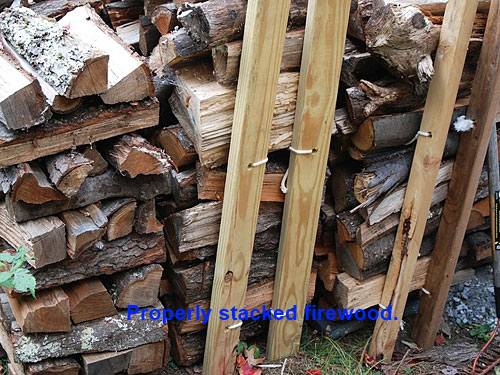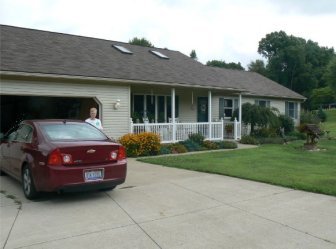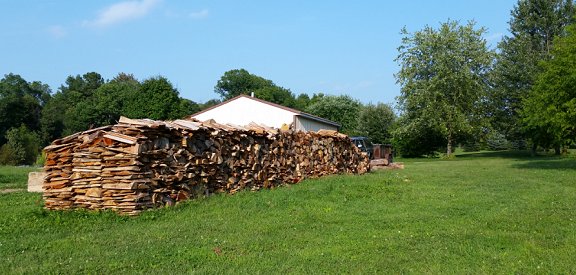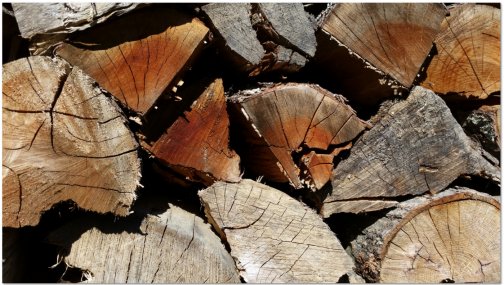|
Click
links
below to
page down to correct paragraph . . .
These links don't cover
everything on this firewood page, please page or scroll up or down to see all.
 ~Do
wood stoves hurt the environment? ~Do
wood stoves hurt the environment?
~What is
"green" firewood?
~How do I "dry" firewood?
~What's best, fireplace or wood stove?
~My opinion on Outdoor Wood Stoves.
~What type chimney is the best ?
~Our home. Heated 90% with
firewood.
~How much money can I
save?
~Is burning firewood for
me?
~Click here to see the best
firewoods to burn.
Note:
This link will take you to another of our
pages. This page will open in a new window, leaving our present page as
is so that you may quickly switch pages.
I've supplemented our home heating system for over
50 years with a wood stove here in northern Ohio.
One cord of seasoned hardwood
will provide
more
home heat than 225
gallons of propane,
2.75 ccf (2,750 cubic feet) of natural gas, or
133 gallons of #2 fuel oil.
Compare your
local prices for each.
Page or
scroll up or down for more . . .
Click
here to return to index (near top of
page) . . .
Some consider wood fuel
to be bad for the environment,
however this
is not the case if proper techniques are used.
.
Firewood is a renewable energy
resource like wind, solar and hydroelectric power. We need to use
more renewable energy and less oil, gas and coal in the
future. Heating with wood can be a part of the solution,
provided the wood is burned efficiently.
When wood heat replaces carbon-producing fuels such as
propane, heating oil or electricity from a coal-burning
plant, then wood burning has a positive impact on the
world-wide carbon footprint. Today,
important technological advances have resulted in
cleaner burning, higher efficiency wood stoves.
Many newer EPA approved wood stoves are over 85%
efficient, meaning that over 85% of the heat produced by your firewood remains
in your home. Wood stoves are safer and much more efficient than wood
fireplaces. Most wood burning fireplaces are less than 15% efficient.
Many people enjoy fireplaces for the comfort of watching a wood fire burn,
however many newer highly efficient wood stoves have glass in the doors that
allows viewing.
Page or
scroll up or down for more . . .
Click
here to return to index (near top of
page) . . .
~
How large is our home?
We heat 90% with Firewood. . .
Our 15 year old home is a large ranch with a full basement. I would guess the total square footage to be
about 2200. Our original (present) heat is a Goodman 3 ton Heat Pump with a
backup gas furnace
(propane) that kicks on when the outside temp drops to below 40 degrees.

We added the wood
burning furnace and connected it into our existing
Heat Pump/Gas furnace ductwork. Our home is well insulated, with over 18 inches
of fiberglass in the attic.
Our Hotblast 1500 heats our home
in the coldest of Ohio weather. The Hotblast 1500 also
keeps our garage warm. It's nice, during these Ohio
winters, to jump into a warm car in the morning. Our
Hotblast doesn't use much firewood but the firewood
must dry. It must be be properly stacked and air dried for
several months. We usually use 4 or 5 cords in a
normal Ohio winter.
Our chimney is Metalbestos, 6"
double wall stainless with a ceramic
refractory blanket insulation encased between walls.
The flue is
straight up, through the attic and roof. Our chimney is not
visible in this photo as it's on the back (north) side
of our roof.
I burn Ohio's local firewoods including Oak, Maple, Hickory, Cherry, Elm,
Locust, and
Ash. I also buy several loads of slab wood from local saw mills, it dries quickly. I
cut about half of my firewood myself. When
I cut my own firewood I usually don't split anything that's under 10 inches in
diameter. I use these large pieces to hold my fires overnight. These large
pieces must be air dried for at least a full year, sometimes a couple
years.
Add a couple 7 inch x 20
inch
Wild Cherries (or two 7" x 20" Elms) to a hot bed
of coals, then put a good dry 8" x 20" White Oak,
Locust, or
Hickory on top and you have a fire that will heat for 12
or more hours and still re-ignite easily from the hot
coals without a match.
Page or
scroll up or down for more . . .
Click
here to return to index (near top of
page) . . .

Photo above: Our back yard
wood pile. This properly stacked wood pile will heat our home for two or three
Ohio winters. This firewood is all cut 18 to 20 inches, split and stacked in 6 feet
wide (3 rows), 5 feet high and 63 feet long. It's on top of a hill in full breeze and
sunlight. This firewood stack holds a total of more than 14 cords. We
usually burn 4 or 5 cords during one of our Ohio winters.
Click here to see close-up.
I always enjoyed cutting
firewood in the '60s and 70s
with my father.
Burning firewood is
not
for everyone. Cutting and burning firewood requires costly equipment
including chain saws, wood stoves, good safe chimneys
and lots of time. I'm 77 now (2016) but I
still enjoy working with firewood. Cutting, stacking and
burning firewood requires considerable investment and takes time, however, it's
good, healthy outside work. I work a while, sit and rest often, pour
myself a cup of coffee,
and enjoy watching the birds and
animals.
March 3rd, 2014.
Four degrees above zero last night, and this is March! The winter of 2013/2014 was exceptionally cold
in
Ohio. (Where's all this Global warming when we need it?) Our home
was toasty warm all winter but we burned
over six cords of firewood last year. We normally only burn 4 or 5 cords.
Page or
scroll up or down for more . . .
Click
here to return to index (near top of
page) . . .
"Green firewood": Ever try to burn freshly cut firewood?
Freshly cut
firewood is called "green" firewood. It contains a lot of water. This
large amount of water is not on the outside of the logs, it's inside,
absorbed into the wood fibers. Proper air drying is the best way to remove this
water from your firewood. This moisture exits the firewood mostly through the ends. This is why it's important to cut your wood into 18 to 22" pieces.
Then properly stack the green firewood and
leave the ends exposed to the open air for 6 months to a full year. Shorter logs
will dry faster, I try to cut mine all about 18". Some
green firewoods are more than half water by weight. Green firewood must air dry before it will
burn efficiently.
Firewood must be cut into
short pieces, split and properly stacked to dry. Freshly cut firewood
dumped in a discordant pile won't ever dry properly. Rain
will run down and soak into cut ends while ground
moisture will migrate up and
soak into spongy inner bark. Wood left in a discordant heap will
soon rot and be rendered useless as firewood. Firewood
must be cut and properly
stacked to dry.
Burning "green" firewood doesn't provide much heat
into the home.
It causes more smoke and
will coat your flue with creosote. Freshly cut "green" firewood has up to 60%
water content and won't burn well in your wood stove. First, you must let the firewood
"season", which allows the moisture to escape. When the wood gets down below 20%
water content, it's ready to burn.
When "green" firewood is burned, the water in the
wood must be boiled into steam to get rid of it. Thousands of BTUs are used to boil the water out of the green wood.
These BTUs are lost as home heat since it they are returned into the outside air as the steam returns to
water vapor.
Let's look at White Oak, a Excellent burning firewood
when "dry or seasoned**". Here's an example of how much water is in "green"
White Oak".
1 cord of "green" White Oak weighs about* 6,290
pounds.
1 cord of air dried White Oak weighs about* 3,710
pounds.
= 2,580 pounds of water in a cord of "green" White Oak
Water is 8 pounds per gallon, so divide by
8
= 322 gallons of water in a cord
of "green" White Oak
If
you must burn Green firewood, this means that 322 gallons
of water must be boiled out of this "green" firewood
before it can heat your home. Try to imagine how much
heat is required to boil over 322 gallons of water. The heat used to
boil this water is lost as home heat.
Page or
scroll up or down to see this complete page . . . or
just
Click
here to return to index (near top of
page) . . .
How do I know when
my firewood is "dry"?
Firewood should be stacked neatly in a dry, sunny area so that air can circulate
completely through the
stack.
Firewood should be cut into 22 inch lengths or shorter
depending on your woodstove's firebox size. I cut my firewood all about
18 to 20 inches long. Shorter pieces dry faster. If you
split firewood will it will dry a little quicker
but splitting isn't absolutely necessary. Firewood dries
mostly from the ends since this is the way that the
water travels through the tree normally. Dry firewood should make a
clear, sharp ringing sound when tapped together. Another clue is seeing cracks
in the ends.

Photo at right shows how firewood should look after
being properly stacked and allowed to dry for a year or more. This photo is a
close-up of the wood stack in my back yard picture (above). Notice the cracks in
the ends of each piece. These are large pieces, 6 to 9 inches in diameter, 18 to
20 inches long. Tapping two of these together produces a clear, sharp "ring",
not a dull "thud". This firewood is ready to burn.
Firewood should be stacked in a sunny area where the
breeze can circulate completely through the stack. The
stack does not need to be covered. It's
best to split and stack firewood soon after it's cut.
This allows the wood more time to dry.
Firewood dumped outside, in a pile
will not dry, and will rot. Rain will run down and soak
into cut ends while ground moisture will migrate up and
soak into the firewood. Firewood left in a heap will
soon rot and be rendered useless.
Here's a
quick drying trick if you're able to do it.
My father taught me this trick. When cutting firewood in
the summer while the leaves are healthy and still on the trees, fell the
tree, leave all the limbs attached. Let the tree lay, with the leaves
on, until they wilt away. This takes a few weeks but the
leaves will pull most of the moisture from the tree.
This will give the firewood a good start in drying.
Note: The three pieces of Ash
firewood at the bottom of the photo above were dried this way.
Notice that the cracks in the ends of these pieces are much smaller.
These Ash pieces are just as dry as the others, the quick drying
trick above had removed most of the moisture before they were
stacked.
How
efficient is your wood stove or fireplace?
Click link below . . .
Click here: Wood stove/fireplace
efficiency facts:
Click here: Dry firewood weight by cubic foot.
Weighing a single
cubic foot of dry wood is a good way to determine
the heat value in BTUs of the species as a firewood.
Interesting, you will remain in this website.
Click here, to find the best
firewoods to burn:
Firewood heating and weight
values. with notes . . .
Sixty different firewoods listed. (You will remain in this website.)
Almost all firewood will
provide good heat, some is just better than others. If you have a choice of
which firewoods to burn, look at this chart to pick the best firewood available
in your area.
|

![]()
![]()
![]()
![]()
![]()
![]()
![]()
![]()



